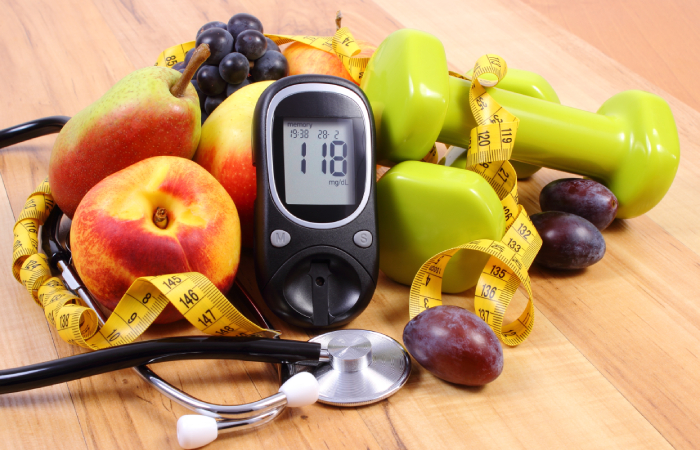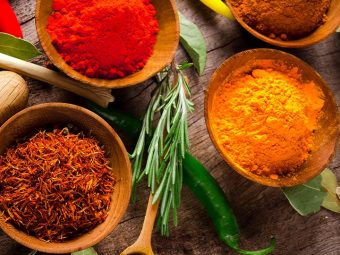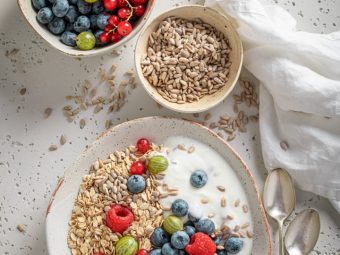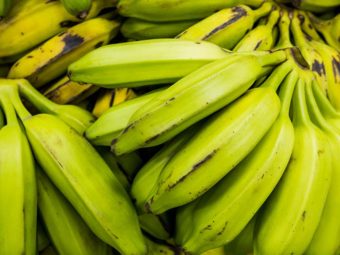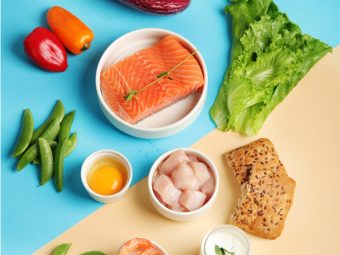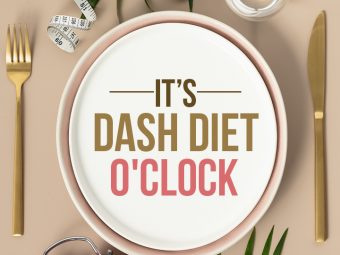Diabetes Diet: Eating Right To Control Blood Sugar
Manage your blood sugar levels with an easy and effective dietary strategy.
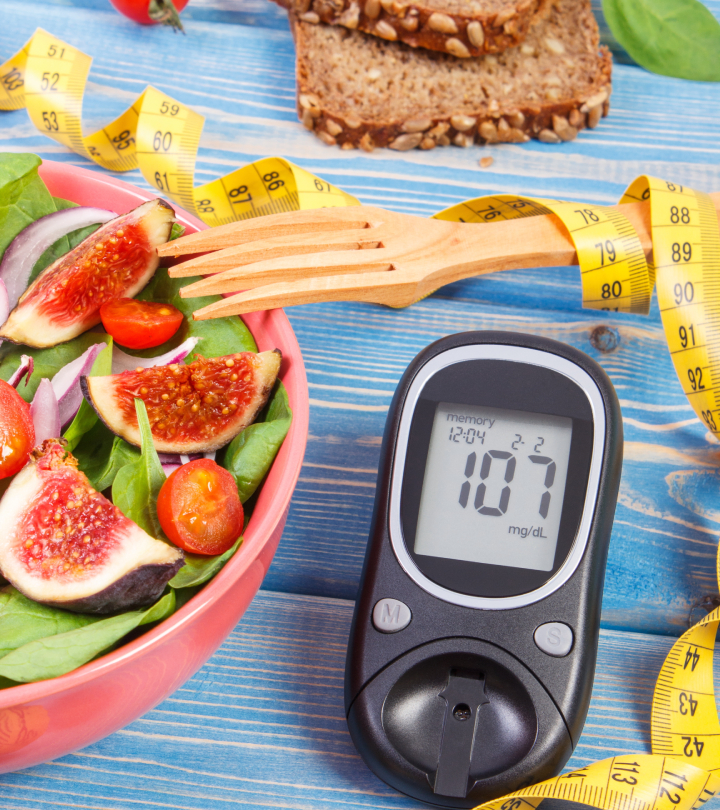
Image: Shutterstock
A strict diet plan is necessary to control diabetes. But that does not mean you have to cut yourself off from delicious food. A well-crafted diabetes diet plan includes fruits, vegetables, meat, and dairy. Maintaining stable blood sugar levels is a daily priority and the choices made in the kitchen play a pivotal role in achieving this goal. But what foods should be included in a diabetes diet? Should you avoid consuming anything? We can help you find the answers to these questions.
This article will explore meal plans, guidelines, and practical tips to help you take charge of your health. Whether you are newly diagnosed or seeking to fine-tune your diet, this article is your roadmap to better blood sugar control. Keep reading to embark on this journey toward a healthier, more empowered you.
 At A Glance: Diabetes Diet
At A Glance: Diabetes Diet- Principle: Consumption of high-fiber, low-fat, and moderate protein foods.
- Purpose: To manage blood sugar levels and manage diabetes.
- Who Is It For: Individuals with diabetes
- Duration: Long-term
- Who Should Avoid: Healthy individuals and those with eating disorders.
- Cons: May be difficult initially to adjust due to the reduced portions.
In This Article
How To Get Started With The Diabetes Diet
Getting diagnosed with diabetes can be an overwhelming experience. It can leave you uncertain about where to begin, what information to trust, and how to modify your daily routine. So, when it comes to adopting new health habits, start with small, manageable steps.
Remove sugary beverages and add more fruits, non-starchy vegetables, whole grains, and lean proteins to your diet. However, there are some important things before you start this diet.
- Increase Protein Consumption: Protein consumption may help improve your blood sugar level and slow down carbohydrate digestion and glucose absorption. Also, it may help you feel full, which may aid in weight loss (1).
- Choose Fiber-Packed Carbohydrates: While carbohydrates fuel your body, they may turn into glucose and affect your blood sugar level more than other foods (2). Therefore, increasing fiber consumption may slow sugar and fat absorption and prevent blood sugar spikes (3).
- Consider Weight Loss: It can help improve insulin resistancei XA condition where the body's cells don't respond effectively to insulin and have difficulty absorbing sugar from the bloodstream. and regulate glucose concentration in the blood. Losing weight improves the insulin’s effectiveness at the cellular level, boosts insulin production, and decreases the liver’s glucose production (4).
- Reduce Sugar Intake: Avoiding sugar is the first step to improving blood glucose levels. Simple carbohydrates may release sugar into your body and cause blood sugar spikes (5).
- Eat Regularly And Keep A Food Diary: Skipping meals, especially breakfast may cause unstable blood sugar levels (6). Eating regular meals and snacks may prevent hunger and help maintain stable blood sugar levels. Maintain a food diary to help track your calories and portion sizes.
- Check The Glycemic Index (GI) Of Foods: The glycemic indexi XA numerical scale that ranks the foods containing carbohydrates based on how quickly they raise blood sugar levels when consumed. gives you an estimation of how quickly carbohydrates break down during digestion. A study found that a low-GI diet can help lower fasting glucose, which may help people with prediabetesi XA condition where you have higher than normal blood sugar levels but not enough to be diagnosed with type 2 diabetes. or diabetes (7).
- Be Careful With Alcohol: People with diabetes who drink alcohol, especially those on insulin or insulin medications, might be more likely to experience low blood sugar (8). Adults with diabetes should limit their alcohol intake to one daily drink for women and two daily drinks for men.
- Reduce Unhealthy Fats And Add Healthy Fats: According to the American Diabetes Association, reduced consumption of saturated and trans fats and increased intake of omega-3 fatty acids may improve cholesterol and fats levels in patients with diabetes (8). A study found that replacing saturated and trans fatty acids with unsaturated fatsi XA type of dietary fat that is considered healthier for your heart and overall health when consumed in moderation. may improve insulin sensitivity and reduce type 2 diabetes risk (9).
- Exercise Regularly: It makes your body more sensitive to insulin and your muscle cells are better able to use any available insulin to take up glucose during and after activity. Also, when you are active and your muscles are moving, your cells can grab glucose and use it for energy, even if insulin is not available (10).
Therefore, it is important to understand these changes before starting the diet. A sustainable diabetes diet should take your health goals, lifestyle, and your medicines into account. Scroll down to know more about it.
What Is The Best Diabetic Diet Plan?
There are several diet plans available for people with diabetes. Consult your doctor or dietician to create an individualized diet plan if you have diabetes. However, a commonly recommended method is the plate method.
Plate Method
It helps you control your portion sizes without counting your calories. It shows the amount of each food group you should eat.
The method involves the following guidelines (2):
- Use a 9-inch plate.
- Fill one-half of the plate with non-starchy vegetables or with complex carbohydrates like millet, whole grains, green leafy vegetables, etc.
- Put protein on one-fourth of the plate.
- Add a grain or other starchy vegetables on the last one-fourth.
 Pro Tip
Pro TipYou may also include small snacks in between meals, a small fruit bowl, and a small glass of milk in your meal plan. However, you should be careful while choosing which foods to include in your diet. Read on to know more.
What Foods Can People With Diabetes Eat Freely?
A healthy diabetes diet involves consuming nutritious foods from all food categories and following the specified portion sizes. The food groups are as follows.
Vegetables
- Non-Starchy: Broccoli, carrots, greens, peppers, and tomatoes
- Starchy: Potatoes, corn, and green peas.
Fruits
- Oranges, guava, papaya, berries, grapes, apples, and bananas.
Grains
- Wheat, quinoa, barley, oats, and cornmeal.
Protein
- Fish, eggs, chicken or turkey without the skin, dried beans, chickpeas, split peas, and tofu.
Dairy
- Non-fat or low-fat milk or lactose-free milk, yogurt, and cheese.
Healthy Fats
- Canola, safflower, sunflower and olive oils, avocado, nuts and seeds, and fish such as salmon, tuna, and mackerel.
These are the foods you can include in your diet. Your dietician may help you decide if you should eat these in smaller portions or enjoy them less often. However, you should strictly limit certain foods to help treat diabetes. Find out in the next section.
What Foods To Avoid With Diabetes
The foods and beverages you need to avoid or restrict are:
- Fried foods and other foods high in saturated and trans fats.
- Sodium-rich foods such as ham, pizza, pickles, and sauces.
- Added sugars such as sweets, baked goods, candy, and ice cream.
- Beverages with added sugars, such as regular soda, juice, and sports or energy drinks.
- Alcohol
Limiting these foods and following a healthy diet plan may help manage your blood sugar levels efficiently. Continue reading for a sample diabetes meal plan.
What Meal Plans Are Best For Those With Diabetes?
| Meal | Foods |
|---|---|
| Breakfast | 1 cup of low-fat plain Greek yogurt, ¼ cup of grapes or blueberries with 3 tablespoons of chopped walnuts. You may also include water, unsweetened tea, or coffee. |
| Lunch | 60-80 g of lean meat, 100 g of fish, or 1 cup of cooked legumes (such as beans or lentils). |
| Snacks | A small serving of reduced-fat natural yogurt with berries or a slice of whole grain bread with thinly spread peanut butter or cottage cheese and tomato. |
| Dinner | 1 serving of baked eggs in tomato sauce with kale and a slice of whole-wheat bread. |
This sample meal plan can give you an idea about how much you need to consume for each meal. However, it may vary depending on the person and medications. Therefore, consult your doctor or dietitian for a customized meal.
Though these restrictions may help you manage your blood sugar levels, you also need to follow some basic eating guidelines to keep them in check. Take a look in the next section.
Basic Eating Guidelines For Diabetes
- Avoid skipping meals and eat regular meals throughout the day.
- Make vegetables the main part of your meal.
- Reduce high-salt foods
- Cut the serving size of your meals and snacks.
- Choose reduced-fat or low-fat dairy products with the least amount of added sugar.
- Consume oily fish such as salmon, sardines, mackerel, herring, or tuna 2 to 3 times per week.
- Use herbs and spices to add flavor to your food.
- Avoid snacking before bedtime.
- Avoid processed or refined foods like pasta, white bread, white rice, and cereals.
 Quick Tip
Quick TipFollowing these eating guidelines alone may not help you manage blood sugar levels. Exercising regularly can help manage your diabetes. Take a look at the next section.
Physical Activity And Diabetes
Being physically active has several health benefits such as (2):
- Lowering blood glucose levels
- Burning extra calories
- Improving your mood
- Improving blood flow
According to the American Diabetes Association, children with diabetes or prediabetes should engage in at least 60 minutes of physical activity each day. Adults with diabetes should engage in at least 150 minutes/week of moderate-intensity aerobic activity and resistance training at least twice per week (8).
Exercising and staying physically active may also reduce one of the biggest risks of diabetes – belly fat. Excess abdominal fat increases the risk of developing insulin resistance due to the release of free fatty acids and problems with the secretion of adipokinesi XSignaling hormones that can influence how the body responds to insulin, which is crucial for regulating blood sugar levels. . This may increase the risk of type 2 diabetes and cardiovascular disease. Losing weight may help improve insulin sensitivity by making changes in how your fat tissue functions (11).
Infographic: Foods To Eat And Avoid On The Diabetes Diet
Managing your blood sugar levels is crucial for your overall health. Consuming whole grains, lean proteins, and fiber-rich fruits and vegetables and avoiding processed foods can help keep your diabetes under control. Check out the infographic below to know which foods to include and exclude from your diet.

Illustration: StyleCraze Design Team
Save the high-quality PDF version on your device now.
Download Infographic
Managing diabetes through a well-balanced diet and lifestyle choices can help you achieve stable blood sugar levels. Include protein and fiber-rich foods with less carbohydrates in your diet to help improve insulin sensitivity. The ideal diabetic diet plan should be personalized to your goals, preferences, and medications. Consult your healthcare professionals or dietitians, control portion sizes, and make informed food choices to effectively manage diabetes and enjoy a healthier, more fulfilling life.
Frequently Asked Questions
When should I eat if I have diabetes?
Some people with diabetes need to eat at about the same time each day while some others can be more flexible with the timing. It may depend on your diabetes medicines or type of insulin. If you take mealtime insulin, your eating schedule can be more flexible (2). Consult your doctor to know when you should eat and whether you should eat before and after physical activity.
Will supplements and vitamins help my diabetes?
No. Supplements and vitamins may not help with diabetes. However, you may need supplements if you do not get enough vitamins and minerals from foods. Consult your doctor before taking any dietary supplement since some may interact with your medications and severely lower your blood sugar levels (2).
What physical activities should I do if I have diabetes?
Aerobic exercises such as walking, jogging, cycling, and dancing for at least 30 minutes a day. If you are interested in moderate physical activities, do strength training and stretching exercises to improve your muscle strength and flexibility.
Is ghee good for diabetes?
Cooking ghee in an open vessel may not cause a spike in blood sugar levels (12). However, consume it in moderate amounts and consult a registered dietitian to determine the amount of ghee you may consume per day.
Key Takeaways
- The diabetes diet focuses on consuming more fruits, non-starchy vegetables, whole grains, and lean protein.
- The plate method is one of the most commonly used methods for weight and diabetes management.
- Cutting the portion size and limiting processed foods may help manage blood sugar levels.
Including nutritious foods and practicing healthy eating habits may help manage diabetes. But how? Watch this video to discover the foods you can add to your diet for better blood sugar control.
Sources
Articles on StyleCraze are backed by verified information from peer-reviewed and academic research papers, reputed organizations, research institutions, and medical associations to ensure accuracy and relevance. Read our editorial policy to learn more.
- Dietary protein is important in the practical management of prediabetes and type 2 diabetes
https://www.sciencedirect.com/science/article/pii/S0022316622086047?via%3Dihub - Diabetes diet, eating, & physical activity
https://www.niddk.nih.gov/health-information/diabetes/overview/diet-eating-physical-activity - Dietary fibre and whole grains in diabetes management: Systematic review and meta-analyses
https://pubmed.ncbi.nlm.nih.gov/32142510/ - Weight loss and the prevention and treatment of type 2 diabetes using lifestyle therapy, pharmacotherapy, and bariatric surgery: Mechanisms of action
https://pubmed.ncbi.nlm.nih.gov/26627223/ - Physiology, carbohydrates
https://pubmed.ncbi.nlm.nih.gov/29083823/ - Skipping breakfast is associated with glycemic variability in patients with type 2 diabetes
https://pubmed.ncbi.nlm.nih.gov/31869658/ - Low-glycemic index diets as an intervention for diabetes: A systematic review and meta-analysis
https://pubmed.ncbi.nlm.nih.gov/31374573/ - Standards of medical care in diabetes—2016 abridged for primary care providers
https://www.ncbi.nlm.nih.gov/pmc/articles/PMC4714725/ - Dietary fats and prevention of type 2 diabetes
https://www.ncbi.nlm.nih.gov/pmc/articles/PMC2654180/ - Exercise and type 2 diabetes
https://www.ncbi.nlm.nih.gov/pmc/articles/PMC2992225/ - Obesity, abdominal obesity, and insulin resistance
https://pubmed.ncbi.nlm.nih.gov/19046737/ - White rice with ghee does not increase blood sugar level in type 2 diabetes patients
https://jddtonline.info/index.php/jddt/article/view/6077/5422






